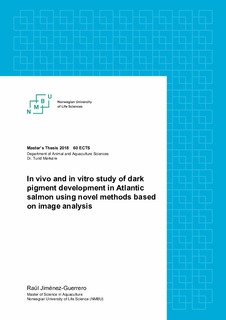| dc.description.abstract | The appearance of skin and fillet muscle of Atlantic salmon, are the most important quality parameters for consumers. Salmon skin with pearl-shiny, bluish appearance is associated with high quality and freshness while a greener appearance is associated with high sexual maturation signs, which is normally linked to poorer fillet muscle quality. Regarding fillet muscle, consumers consider any dark discoloration with lower quality. Dark pigments are associated with deposition of melanin pigments. The melanin biosynthesis pathway has strong similarities at these two levels on salmon. Melanisation of the skin and skeletal muscle, and in vitro through SHK-1 cells, has not been studied simultaneously. The main goal was to study dark pigment development in salmon obtained from feeding trials at three different levels; skin, skeletal muscle and in vitro cell culture using SHK-1 cells. The fish were fed either a standard diet or diets added Antarctic krill meal. New objective methods based on image analysis were developed to study skin appearance and dark discoloration of fillets. Additionally, SHK-I cells were conditioned for producing dark pigments in vitro, using plasma as growth medium, obtained from post-smolts salmons fed with zero, low or high krill inclusion level.
Results from the image analysis showed that salmon fed low krill meal diet had darker and bluer appearance, while high krill meal resulted in a darker and greener appearance compared with salmon fed the standard diet. The fillets had high prevalence of dark discoloration, but the hyperpigmented areas were generally small in all groups. The inclusion of krill meal had no significant effects on the dark discoloration severity, but the low krill inclusion showed discoloration towards red type. A positive correlation was found between the general b* value of salmon skin, and the b* value of the cranio-hypaxial muscle, which suggested a relationship between carotenoids levels in both structures. Additionally, as was hypothesized, a positive correlation between the dark pigmentation of skeletal muscle and skin melanin was found. No significant differences were seen at in vitro level in the relative expression of the tyrosinase relate family enzymes under different plasma conditioning from salmon fed graded krill meal levels. | nb_NO |

